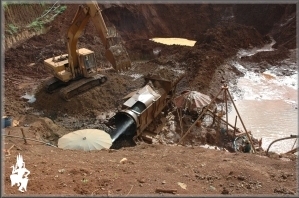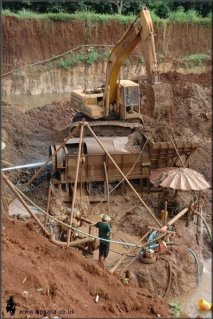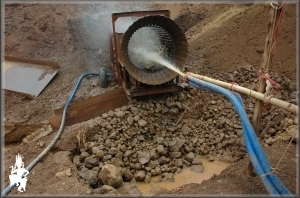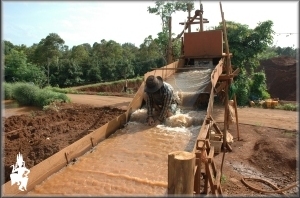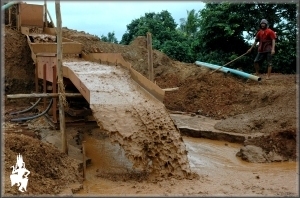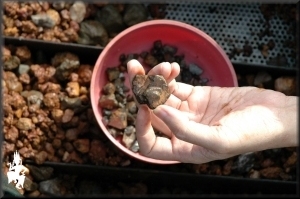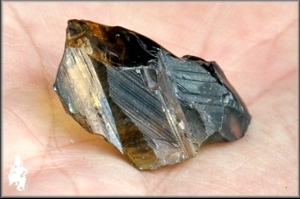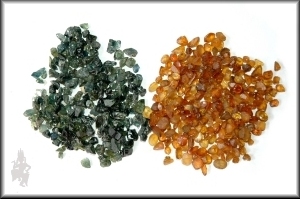Gem Mining at Bang Kacha - บางกะจะ
|
The gem mining region of Bang Kacha is located approximately 240 km south east of Bangkok, in the district of Tha Mai, Chanthaburi province, Thailand. The gems are found in placer deposits, scattered around the fruit orchards that surround Khao Ploi Waen (Hill Of Gems). Gem mining takes place mostly during the monsoon season; when there is enough water available to operate the hoses and pumps used to wash and process the gem bearing soil. The mining methods used in Bang Kacha vary widely, from traditional hand dug pits to mechanised open cast mining. Open cast mining produces the highest yield but the financial costs are relatively high. Occasionally smaller pits can be found around Bang Kacha, which are dug out using a mechanical digger but worked on by hand. The traditional hand dug pits are seldom used these days but can still be found on private land or being used at non-licensed illegal diggings. |
|
Traditional pit mining. |
Traditional Pit Mining A vertical shaft is dug by hand until the gem bearing level is reached. A makeshift bamboo crane is used to hoist the buckets of soil to the surface, which are then taken away to be washed and sieved for gems. There is usually one person digging and one or two people raising the buckets and washing the soil. This method is very dangerous as there is nothing to support the pit & cave-ins can occur quite easily. It is also back breaking work and only yields a small amount of gems. Traditional pit mining methods were used fairly extensively up until about twenty years ago but have become a bit of a rarity today. |
|
Open Pit Mining Dotted around Bang Kacha you will also find the odd small open pit that has been dug out using a mechanical digger but worked on by hand. These operations are much smaller than the full-scale open cast diggings but much less costly. The miners will hire the use of a mechanical digger to dig a pit down to the gem bearing level, which is usually a few metres deep. Small pockets of gem bearing soil are then dug out by hand and sieved through to retrieve the gems. There are usually three or four people working on these diggings. The quantity of sapphires found using this method could be less than a handful a day. The financial cost of these operations is relatively small. There is the initial outlay to hire the digger but once the gem bearing level has been reached the rest of the work is all manual. |
 Open-pit sapphire mining.
|
|
Open cast mining. |
Open Cast Mining Work on open cast mining operations is seasonal. A huge amount of water is required to work the hoses used to wash the soil. This limits mining to the monsoon season, usually between May and September. Mining companies will approach landowners and lease plots to dig for sapphires. The parties will make an agreement, which will involve paying the landowner a percentage of the value of the gems recovered. |
|
Once the pit has been dug, a large rotating drum is set up along with the pumps and hoses. The soil is dug out using a mechanical digger and tipped into the rotating drum. A high-pressure hose then washes the soil, as the drum slowly rotates. This separates the soil and gravel from the larger rocks. The larger rocks drop out the front of the rotating drum and are removed from the pit. Anything smaller than a golf ball, is pumped up out of the pit to a pulsating jig. The jig is usually placed on the side of a previously dug out pit. The soil pumped up from the new pit is then used to fill the old disused pit. This ensures minimal environmental damage as fruit orchards can later be planted on the filled pits. In the late afternoon or once the jig is filled with gravel, the hoses and pumps are shut down. The miners then climb onto the jig and slowly rake through the gravel and pick out the gems. |
Digging, washing and pumping. |
|
Washing the soil in the rotating drum. |
Production from these operations can vary a lot from pit to pit. One group of miners I spoke to at a larger operation were finding between three to five kilos of sapphires a day. Another mine I visited was only producing about half a kilo a day. As the sapphires are usually found in pockets it is also possible to dig all day and not find any gems. The size of the sapphires found can vary from small chips to crystals weighing over a hundred carats. The financial cost of running an average sized open cast mine is approximately 10,000 baht per day. |
|
The high pressure hose used to wash the soil in the rotating drum. |
A pulsating jig used to separate the gem bearing gravel from the soil. |
|
Bang Kacha’s Gems There are a variety of gems found at Bang Kacha but these are mostly sapphires. Dark red pyrope garnets & zircons are also found but the quality is not so good and most are sold into the local market. Bang Kacha’s most famous gem has to be the golden coloured sapphire. Prior to the arrival of beryllium treatments at the end of 2001, these gems could command prices that almost matched those asked for fine quality blue sapphires. The most prized colour of these sapphires is said to match that of whisky. Green sapphires are also found in significant quantity but the colour can sometimes be quite dark. There are, however, some very fine grass-green sapphires unearthed at Bang Kacha, sometimes weighing over ten carats. There are also sapphires with a combination of the golden and green colour, producing a very pleasing virgin olive oil colour. These stones are quite rare and can be expensive. |
|
Star sapphires are also found in fairly large quantities. The star colour is usually silver on a black stone. The stars are a result of intersecting hematite needles, which give the stone its distinctive black colour. The hematite silk produces a star phenomenon that is much coarser than the stars produced by fine rutile needles, that is found in star sapphires from other regions. Twelve rayed stars are sometimes seen when there is a combination of hematite and rutile silk. Occasionally, the star sapphires are found with a golden body colour, which combined with the dark hematite needles produces a gold star sapphire. These gems are very rare and highly prized amongst locals; hence they can be surprisingly expensive. Blue sapphires are also found but only in small quantities and tend to be a fairly dark blue colour. |
Water pouring down from a pulsating jig. |
|
An iron stained sapphire crystal. |
A cleaned sapphire crystal showing gold and dark green colour. |
|
Green sapphires turned orange after beryllium treatment. |
Treatments Probably the biggest effect on Bang Kacha’s gem industry was the arrival of the beryllium treatment in late 2001. It was discovered that high temperature heat treatment of green sapphires in the presence of beryllium, would turn the sapphire’s colour to a bright orange. The same effect was seen in green sapphires from other regions. This caused a complete collapse in prices of yellow & orange sapphires. Highly prized golden sapphires of Bang Kacha were being traded at a fraction of their pre-beryllium treatment prices. Today the price of golden sapphires has recovered somewhat but even now a golden sapphire can be bought for about a fifth of the price of a comparable stone, prior to beryllium treatment. The effect beryllium treatment had on prices has today led many of Bang Kacha’s miners and dealers, not to treat their sapphires and keep them totally natural. |
|
As with other gem mining regions, the financial costs of mining have risen considerably over the past few years. This has led to a significant fall in production and pushed the cost of finished gems almost beyond the price the market is prepared to pay. A few years ago there were open cast mining ventures all around Bang Kacha. Today there are still ventures operating but you have to search a lot harder to find them. With the general downturn in the world economy, it is difficult for the price of the finished gems to maintain the level needed to keep mining economically viable. This could unfortunately lead to these gem deposits becoming too expensive to operate and lead to mine closures. |
|
A selection of sapphires from Bang Kacha |









